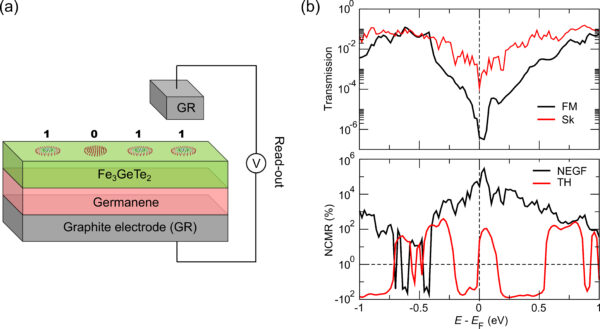Study of noncollinear magnetoresistance by ab initio quantum transport
February 26, 2024
Magnetic skyrmions – topologically stabilized chiral spin structures with size down to the nanometer scale – have emerged as a promising avenue to realize next-generation spintronic devices. A researcher from the MEM group at CEMES-CNRS, in collaboration with the University of Kiel (Germany), has just proposed a novel approach to detect skyrmions using an electric current.
Ten years ago, Albert Fert and co-workers first proposed to use skyrmions in a racetrack memory in their seminal paper. Today, many other potential applications of skyrmions are being explored, ranging from logic devices to neuromorphic or quantum computing. An essential prerequisite for most applications is reliable electrical detection of individual skyrmions or other topological spin structures.
In 2020, magnetic skyrmions were first experimentally observed in two-dimensional (2D) van der Waals (vdW) magnets, providing an ideal playground to advance skyrmion technology towards the single-layer limit with large tunability via external stimuli.

Figure 1: (a) Schematic representation of the proposed vertical tunnel junctions with nonmagnetic electrodes for electrical readout of skyrmions in 2D vdW magnets, e.g., in racetrack memory. (b) Transmission functions for the ferromagnetic state (black) and the Néel-type skyrmion state (red). Corresponding NCMR (black), calculated by the nonequilibrium Green’s function (NEGF) method. The NCMR obtained in the Tersoff-Hamann (TH) approximation (red) is shown for comparison.
Scientists from CEMES-CNRS and the University of Kiel in Germany have now been able to demonstrate that all-electrical detection of skyrmions in tunnel junctions based on 2D vdW magnets (see Fig. 1a) is feasible with straightforward implementation into device architectures. They report on their discovery in the journal Nano Letters [1].
They proposed a tunnel junction based on the vdW Fe3GeTe2/germanene interface, where sub-10 nm skyrmions can be stabilized even without magnetic fields, as demonstrated by their previous publication [2]. An extremely large noncollinear magnetoresistance (NCMR) of above 10,000% is predicted for atomic-scale skyrmions a vdW tunnel junction based on graphite/Fe3GeTe2/germanene/graphite. Notably, the NCMR is more than two orders of magnitude higher than that obtained for conventional transition-metal interfaces.
From a fundamental point of view, the physical mechanism is explained by the interplay between the spin mixing and orbital symmetry matching effects at the interface. Additionally, their work also highlights the crucial importance of using the nonequilibrium Green’s function (NEGF) approach for quantum transport on noncollinear spin structures in tunnel junction devices, going beyond the Tersoff-Hamann (TH) approximation (see Fig. 1b). Their proposal opens a new route to realize skyrmion racetrack memories based on atomically thin vdW materials with full-electrical writing and reading, using a low-energy-consuming method.
Publications:
[1] Proposal for all-electrical skyrmion detection in van der Waals tunnel junctions
Dongzhe Li, Soumyajyoti Haldar, and Stefan Heinze
Nano Lett. (2024)
https://doi.org/10.1021/acs.nanolett.3c04238
[2] Strain-driven zero-field near-10 nm skyrmions in two-dimensional van der Waals heterostructures
Dongzhe Li, Soumyajyoti Haldar, and Stefan Heinze
Nano Lett. 22, 7706–7713 (2022)
https://doi.org/10.1021/acs.nanolett.2c03287
Contact:
Dongzhe Li | dongzhe.li[at]cemes.fr


